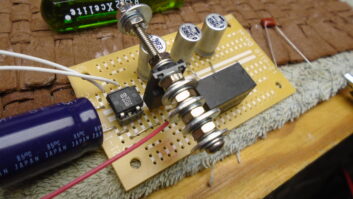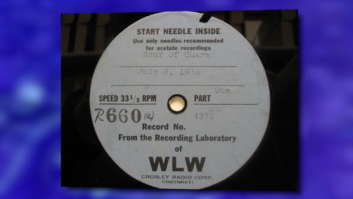Here’s a cool trick for Workbench readers from Stephen Poole, chief engineer of Crawford Broadcasting in Birmingham, Ala.
Stephen needed to replace a badly burned AM sampling line but questioned whether he should call in a cable locator. His experience with contractors was less than stellar and they are costly for a few minutes of work. There had to be a better way.
He discussed his options with CBC Director of Engineering Cris Alexander and they had an idea: Why not just use the field strength meter?
Stephen took an RF signal generator and set it for 560 kHz; there were no stations around operating anywhere near that frequency.
He then disconnected the sample line to the tower in question at the transmitter building, and connected the hot lead from the generator to the cable’s shield. The ground clip was connected to the building ground.
The process worked great. While standing at the base of the tower and pointing the field strength meter toward the ground, Stephen walked around until he saw a strong indication on the meter. This happened whenever he was right over the sample line.
The next step was to bring in a backhoe operator and start digging. All the coaxial lines were exposed in a matter of minutes.

Fig. 1: Keep the soil pipe plugged with foam or insulation. The location was right at the end of the soil pipe that swept the lines up under the ATU. Stephen was able to pull the replacement cable right through the pipe and into position. Don’t forget to plug this open pipe where it enters the ATU cabinet or building (Fig. 1).
If you try this technique you will find that it takes surprisingly little signal, even with a deeply-buried line.
Choose a relatively low frequency that’s well away from any local stations and you’re good to go. You’ll also have to turn off your own transmitter while you do this to prevent interference.
The other key is meter orientation.
You already know how to aim a field strength meter; its antenna is bidirectional, with maximum signal strength in the plane of the meter (i.e., to the “sides”).
In this case, you point the side of the meter down, toward the ground. Don’t swing it around; keep the meter at a fixed right angle to the ground and in line with the transmitter building and tower. Carefully walk around, watching for the highest indication and you’ll find your line.
I’ve used this technique to find ground radials — or the absence of them! No need to use a signal generator here, the AM transmitter is your signal generator. By holding the antenna close to the ground and sweeping it from side to side, you can “follow” a radial as it stretches out from the tower.
Thanks to Cris Alexander and Stephen Poole for sharing an inexpensive way to find buried coax.
* * *
Engineer Randy Howard sent in a note after reading our discussion in the March 25 issue about troubleshooting three-phase or even single-phase circuits.
The only place to check voltages is across the fuse, Randy writes.
If you put your probes on each end of the fuse and see nothing, the fuse is good. (There is no voltage “drop” across the fuse.)
If you measure line voltage, or any voltage, the fuse is open, or at least not good. (The open fuse permits a voltage drop to be measured across it.) Turn off the primary power to the box, change the fuse and turn the power back on.
I make it a point to measure again — too many times have “good” fuses turned out to be bad.
If everything works, your fuse died of metal fatigue.
If the fuse pops again, turn off all loads to that box, replace the fuse (see above for safety) and start reapplying the loads one at a time (Fig. 2).

Fig. 2: After replacing the main disconnect fuse, turn on each sub panel breaker one at a time. When the fuse pops as you add another load, you’ve found the culprit and need to troubleshoot that piece of gear or circuit.
Most transmitters allow measuring individual legs of three-phase applied to them. One leg that has voltage but is different from the other two by more than a few Volts is suspect.
Randy adds one other tip. Some older transmitter sites may be powered with “open delta” 240, three-phase service. Watch that third leg. Instead of 120 VAC, it’s closer to 180 V to ground, and called the “wild leg.” It will fry most 120 VAC broadcast equipment connected to it.
* * *
Have you priced replacement tube transmitter blower motors recently?
Mike McCarthy and Bill Bowin had an interesting exchange on the Radio-Tech listserv on Broadcast Net recently.
Mike had bought a replacement motor but planned on having the bearings replaced on the dead one and to use that as a spare.
He was concerned about the life cycle of rebuilding these motors, however. Bill Bowin of Columbus, Ohio, brought up the issue of bearing quality.
Using a cheap bearing will not save you money. Bill suggested contacting a bearing distributor like Applied Industrial Technologies (formerly Bearings Inc.) for the best quality bearing for the blower motor. It may cost a bit more but the difference is worth the price, he says.
Applied Industrial Technologies can be found at www.applied.com.
Bill added that back in the late 1980s, he was having problems with even good blower bearings lasting only a year or two. A quick disassembly of a new sealed bearing assembly revealed very little grease inside.
After that, he started carefully prying off the dust seals and packing new bearings with wheel bearing grease. Bill admits it’s a messy job, but effective. He found that bearing life increased eight- to 10-fold.
John Bisset has worked as a chief engineer and contract engineer for 39 years. He is international sales manager for Europe and Southern Africa for Nautel and a past recipient of SBE’s Educator of the Year Award. Reach him at[email protected]. Faxed submissions can be sent to (603) 472-4944.
Submissions for this column are encouraged and qualify for SBE recertification credit.












